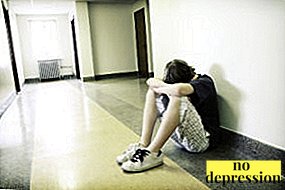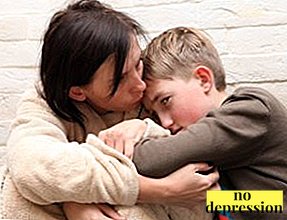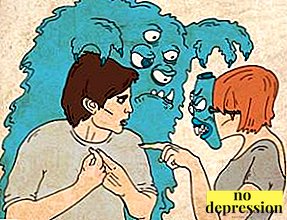Schizophrenia - severe mental illness with a chronic course. It most often develops at a young age: after 20 years in boys and after 26 years in girls.
But there are cases when this disease occurs in children and adolescents. Symptoms and signs of schizophrenia in adolescents closely related to the characteristics and degree of neglect of the disease, the personal characteristics of the patient and his age.
General information

Adolescence - fertile ground for the development of various kinds of mental abnormalities, since during this period the child is especially vulnerable due to hormonal changes that occur in his body.
This is a natural stage of growing up, during which the child rethinks his life, looking for new landmarks, tends to separate emotionally from parents or guardians, trying to declare himself as a practically adult person, whose opinion should be listened to.
It is during the transitional age that the likelihood of developing schizophrenia increases significantly, compared with earlier age periods.
Schizophrenia is a mental disorder in which pathological changes are observed in thought processes, in the emotional sphere, in perception.
The disease has many varieties and characteristics of manifestation. According to various sources 0.5% to 1% of people in the world suffer from schizophrenia.
Schizophrenia is often accompanied by other mental disorders (different types of anxiety disorders, depression, obsessive-compulsive disorder), which aggravate the course of the disease and make it difficult to diagnose.
Schizophrenics are also 40% more likely to suffer. alcoholism, and most of them find it difficult to work because of preconceptions about their illness. Therefore, many of them, even if they are in steady remission, cannot enter the society and often try to commit suicide.
but it is important to understand: most schizophrenics are not at all dangerous for society, and even patients with severe forms of the disease are more dangerous for themselves and not for people close to them.
The sooner schizophrenia develops, the more capable it is. affect the future life of the child.
Causes

Studies to establish the causes of schizophrenia are still underway, and it is impossible to say for sure which prerequisites affect its occurrence, but long-term observation of patients and the study of their DNA allowed us to identify several reasons:
- Genetic features. About 40% of schizophrenics have relatives, in the history of which there is this or other mental disorders. If a close relative of the child has schizophrenia, the probability that she will pass on to him is 10%.
- Adverse social conditions and the specifics of education. Children growing up in families of alcoholics and drug addicts are more likely to have serious mental health problems. Also of great importance is the atmosphere prevailing in the family. The most dangerous in terms of the likelihood of developing schizophrenia in children are families where parents are toxic to one degree or another.
If parents beat, humiliate, insult or ignore children, use them in criminal spheres, seek to control them excessively, demand unconditional obedience from them, then such a family is unequivocally toxic.
- Strong psycho-emotional turmoil. Depending on the personal characteristics of the child, many events may even come as strong shocks, even those that will not be traumatic for most children. Examples: the death of relatives, friends, pets, getting into an accident, an acute episode associated with public humiliation, rape or other acts of a sexual nature, beatings.
- Drug addiction, alcoholism. The teenager is extremely susceptible to the influence of peers and other people who surround him, while parents rarely enter this circle of trust. If the child is in an unfavorable environment, he may develop alcohol or drug addiction. Hallucinogenic drugs are particularly likely to cause schizophrenia to develop.
 Violations that occurred during the formation of the fetus and during childbirth. Infectious diseases (hepatitis, measles, cytomegalovirus) transferred during pregnancy increase the risk of developing disorders in the child’s brain. Also, the probability increases if the mother took drugs that adversely affect the fetus, consumed a large amount of alcohol, was exposed to toxic substances, including drugs, during the gestation period.
Violations that occurred during the formation of the fetus and during childbirth. Infectious diseases (hepatitis, measles, cytomegalovirus) transferred during pregnancy increase the risk of developing disorders in the child’s brain. Also, the probability increases if the mother took drugs that adversely affect the fetus, consumed a large amount of alcohol, was exposed to toxic substances, including drugs, during the gestation period.- Schizoid personality type. Children with this accentuation are closed, tend to protect themselves from others, they often report that they are not interested in communicating with them. They also find it difficult to understand the emotional experiences of other people. Immersed in fantasies and hobbies, laconic.
Also at risk are adolescents who:
- They live in large cities. City dwellers suffer from schizophrenia and other mental illnesses much more often than rural people. Perhaps this is due to the overly tense, stressful rhythm of life in cities.
- Belong to the male gender. On average, men develop schizophrenia earlier than women, so the majority of adolescents with this disease are boys.
But while schizophrenia with the same probability can develop in a person of either sex, and if you take a random group of people over 35 years old, among them there will be approximately the same number of schizophrenics of both sexes.
- Born in winter or spring. Researchers have not yet found this explanation.
However, even a coincidence on several points does not guarantee that the child will have schizophrenia.
About the causes of schizophrenia in children and adolescents in this video:
Forms and stages
The following forms of schizophrenia are distinguished:
 Paranoid In this form of the disease, hallucinations and delusions predominate, and other symptoms are alleviated or absent. Patients are irritable, often show aggression, mistrustful. It is quite rare in adolescents, since it usually appears later in life.
Paranoid In this form of the disease, hallucinations and delusions predominate, and other symptoms are alleviated or absent. Patients are irritable, often show aggression, mistrustful. It is quite rare in adolescents, since it usually appears later in life.- Catatonic. The clinical picture is based on psychomotor deviations: alternation of stupor and arousal. A rare kind of schizophrenia.
- Gebefrenicheskaya. In the behavior of patients prevails foolishness, deliberately childish behavior. Despite the fact that this form is not common, it is quite common in adolescence.
- Undifferentiated. This diagnosis is made in cases when the patient has several key symptomatic features that correspond to different forms of schizophrenia, or in cases where the symptoms are not sufficiently clear.
- Residual. A form characterized by the presence of symptoms of a schizophrenic defect: a desire for isolation, a disturbance in thinking, emotional coldness. May occur after successful treatment of acute psychosis.
- Simple. Often observed in adolescence. Patients are apathetic, limp, exhibit emotional coldness, detachment, shy, infantile, unproductive in their studies.
In some cases, the symptoms of simple schizophrenia are ignored for a long time: relatives of the patient consider him to be lazy, or write it off as features of the adolescent period.
By features of the flow schizophrenia is divided into:
- continuous;
- fur coat;
- recurrent;
- sluggish.
Stages of schizophrenia:
 The first stage. At this stage, the first symptoms of schizophrenia appear, the character of a person gradually changes. He begins to see the world differently: in anxious or excessively beautiful tones. During this period, he may feel as if the truth was revealed to him. If the first stage passed by the patient quickly and was bright, this is a favorable symptom.
The first stage. At this stage, the first symptoms of schizophrenia appear, the character of a person gradually changes. He begins to see the world differently: in anxious or excessively beautiful tones. During this period, he may feel as if the truth was revealed to him. If the first stage passed by the patient quickly and was bright, this is a favorable symptom.- Second stage The patient adapts to the changes in his life, and his illusory worlds coexist in parallel with the real world. A teenager may begin to see duality in everything that surrounds him, for example, he may perceive his friend as an angel or an alien and as an ordinary person whom he knows well at the same time.
- The third stage. At this stage, there is a degradation. There are significant pathological changes in the emotional and cognitive intelligence, the patient's thoughts become more stereotyped.
The third stage of schizophrenia is the most unfavorable in terms of prognosis. In this case, the transition into it can happen very soon or not happen at all.
It all depends on the treatment, attitude to the patient, the form of the disease, personal characteristics and much more.
How is schizophrenia in children and adolescents different from autism? Find out from the video:
First signs
How does schizophrenia manifest in adolescents? The most common symptoms are:
 Pronounced changes in personality. A friendly teenager can suddenly become aggressive, irritable, lose interest in learning and to all that he was dear.
Pronounced changes in personality. A friendly teenager can suddenly become aggressive, irritable, lose interest in learning and to all that he was dear.- Break communication with friends. And for a healthy teenager this is completely normal, but radical changes may indicate the presence of mental disorders (and this is not always schizophrenia). Previously, a sociable child may become withdrawn, lose all his friends and not be willing to find new ones, look detached.
- Lack of initiative, apathy. Previously hard-working teenager can begin to lie down for hours on the couch.
- Change of interests. There may be new hobbies, sometimes unusual, atypical, starting with an interest (sometimes excessive, fanatical) in horoscopes, anti-scientific theories and ending with an interest in books on philosophy, a love of collecting and collecting.
- Changes in mood. For a long time, either depressed or high spirits persist. Also, a child may experience sudden mood swings, sometimes unreasonable.
For adolescent schizophrenia, the appearance of hallucinations and delusions is uncharacteristic. Usually they arise later, as the disease progresses, or do not appear at all: it all depends on the form of schizophrenia.
It is important to understand that some of these symptoms can occur in a healthy adolescent as well as in a teenager with other mental disabilities (bipolar disorder, depression).
Symptoms

The main symptoms of the disease:
- rave;
- broken speech and thinking;
- auditory hallucinations;
- love of empty, stereotypical philosophizing, wisdom;
- emotional coldness, indifference to the problems of people, even close ones;
- stiffness in movement;
- a stiff, emotionless face that looks like a mask;
- negative changes in behavior;
- deterioration of performance;
- rudeness, irritability, aggressiveness;
- suspicion;
- mood swings;
- abundance of neologisms in speech;
- the desire to keep aloof from people;
- lack of will.
Teenagers with schizophrenia addicted to alcohol. They stop caring for themselves, refuse to eat or, on the contrary, eat greedily and a lot.
The desire to be surrounded by people can become extremely pronounced: a teenager locks himself in a room and does not leave it for days, categorically refuses to leave the apartment. If a teenager lives on his own, he does not leave his habitat or goes out only for urgent needs.
Auditory hallucinations predominate in schizophrenia (the patient hears voices that can accuse him, order, humiliate, praise), but the appearance of visual, tactile, olfactory is possible.
There are no pronounced differences between girls and boys for schizophrenia, except for the fact that in most cases girls develop later the prognosis is more favorable.
Malignant continuous schizophrenia often develops in boys, and the first signs of the disease are more often observed in early adolescence (under 16).
Diagnostics

The main methods of diagnosis of schizophrenia:
- Conversation. The psychiatrist is talking to a teenager, asking him about his hobbies, about the attitude towards the people around him, about the situation in the school. He also communicates with the close relatives of the adolescent, sometimes with his friends, teachers, and on this basis makes an approximate picture of the disease.
- Monitoring the patient. During the conversation, the specialist notes the characteristic features of schizophrenia behavior, movements, facial expressions, thinking.
- Conduct special tests. With their help, check the cognitive abilities of a teenager.
In parallel, the patient undergoes a number of other examinations to exclude somatic pathologies, which can be observed symptoms similar to schizophrenia (epilepsy, HIV, autoimmune diseases, metabolic disorders, hormonal disruptions, traumatic brain damage, syphilis).
It is important for a psychiatrist to differentiate between schizophrenia and other mental disorders: bipolar disorder, schizoaffective disorder, borderline syndrome, major depressive disorder.
Treatment methods
The main treatments for schizophrenia are:
- Drug therapy. Each patient is individually selected drugs, and in the process of treatment, this list may vary. Schizophrenia is usually treated with the following groups of medications: atypical antipsychotics (Asenapine, Clozapine), benzondiazepines (Nitrazepam, Diazepam), mood stabilizers (lithium preparations, Carbamazepine, Topiramate).
- Psychotherapy. Allows you to alleviate some of the symptoms, improve the emotional and volitional spheres, reduce stress levels. Also, the therapist will help the teenager get used to the idea that he is sick.
 Social rehabilitation. There are special institutions that will help the teenager to adapt to society. If the disease appears moderately and responds well to medical treatment, the teenager returns to the usual educational institutions. The ability to be among people has a positive effect on the emotional state of the patient, improves the prognosis, prevents autisation.
Social rehabilitation. There are special institutions that will help the teenager to adapt to society. If the disease appears moderately and responds well to medical treatment, the teenager returns to the usual educational institutions. The ability to be among people has a positive effect on the emotional state of the patient, improves the prognosis, prevents autisation.
It is important to treat a teenager with schizophrenia with care, kindness, and understanding so that he feels safe.
Forecast
The prognosis for schizophrenia depends on many factors: the form and course of the disease, the personality of the adolescent, his interest in the real world, the effectiveness of drug therapy, the presence or absence of support from close friends and relatives. Young men have a less favorable prognosis than girls..
Parents and friends of a teenager with schizophrenia should abandon stereotypes regarding this disease so as not to aggravate his condition, and try to treat him as well as possible.
It is useful to consult with the patient's doctor: he will tell you how best to interact with him. The warm and caring attitude of loved ones plays a significant role in the treatment process and at times improves the prognosis.

 Violations that occurred during the formation of the fetus and during childbirth. Infectious diseases (hepatitis, measles, cytomegalovirus) transferred during pregnancy increase the risk of developing disorders in the child’s brain. Also, the probability increases if the mother took drugs that adversely affect the fetus, consumed a large amount of alcohol, was exposed to toxic substances, including drugs, during the gestation period.
Violations that occurred during the formation of the fetus and during childbirth. Infectious diseases (hepatitis, measles, cytomegalovirus) transferred during pregnancy increase the risk of developing disorders in the child’s brain. Also, the probability increases if the mother took drugs that adversely affect the fetus, consumed a large amount of alcohol, was exposed to toxic substances, including drugs, during the gestation period. Paranoid In this form of the disease, hallucinations and delusions predominate, and other symptoms are alleviated or absent. Patients are irritable, often show aggression, mistrustful. It is quite rare in adolescents, since it usually appears later in life.
Paranoid In this form of the disease, hallucinations and delusions predominate, and other symptoms are alleviated or absent. Patients are irritable, often show aggression, mistrustful. It is quite rare in adolescents, since it usually appears later in life. The first stage. At this stage, the first symptoms of schizophrenia appear, the character of a person gradually changes. He begins to see the world differently: in anxious or excessively beautiful tones. During this period, he may feel as if the truth was revealed to him. If the first stage passed by the patient quickly and was bright, this is a favorable symptom.
The first stage. At this stage, the first symptoms of schizophrenia appear, the character of a person gradually changes. He begins to see the world differently: in anxious or excessively beautiful tones. During this period, he may feel as if the truth was revealed to him. If the first stage passed by the patient quickly and was bright, this is a favorable symptom. Pronounced changes in personality. A friendly teenager can suddenly become aggressive, irritable, lose interest in learning and to all that he was dear.
Pronounced changes in personality. A friendly teenager can suddenly become aggressive, irritable, lose interest in learning and to all that he was dear. Social rehabilitation. There are special institutions that will help the teenager to adapt to society. If the disease appears moderately and responds well to medical treatment, the teenager returns to the usual educational institutions. The ability to be among people has a positive effect on the emotional state of the patient, improves the prognosis, prevents autisation.
Social rehabilitation. There are special institutions that will help the teenager to adapt to society. If the disease appears moderately and responds well to medical treatment, the teenager returns to the usual educational institutions. The ability to be among people has a positive effect on the emotional state of the patient, improves the prognosis, prevents autisation.

